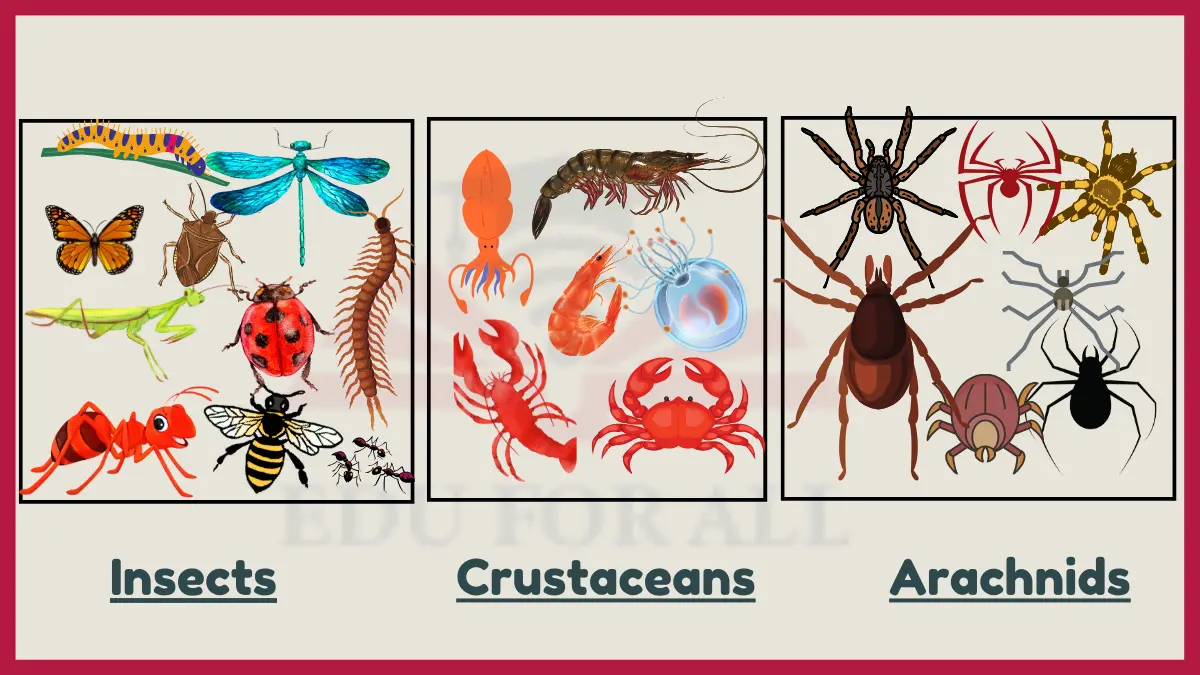Cnidarians, Sponges, Flatworms, Roundworms, Segmented worms, Mollusks, Rotifers, Echinoderms, Arthropods, Annelida, Platyhelminthes, and Platyhelminthes are some groups of invertebrates.

Examples of Invertebrates
Here are some Examples of Invertebrates:
1. Insects
Insects are the largest group of animals on Earth, with over a million known species. They have a segmented body, six legs, and two antennae. They also have a pair of wings, although some insects, such as ants and termites, are wingless.
Insects rely on a hard exoskeleton that protects their soft bodies. They also have a variety of adaptations that allow them to live in different habitats and eat different foods.
For example, bees have long tongues that allow them to collect nectar from flowers, and mosquitoes have sharp proboscises that they use to pierce the skin of animals and suck their blood.
2. Crustaceans
Crustaceans are another example of invertebrates, with over 50,000 known species. They include crabs, lobsters, shrimp, barnacles, crayfish, and krill. Crustaceans have a segmented body, ten legs, and two pairs of antennae. They also have a hard exoskeleton that protects their soft bodies.
Crustaceans rely on their exoskeleton for protection and support. They also have a variety of adaptations that allow them to live in different habitats and eat different foods.
For example, crabs have strong claws that they use to crush food, and lobsters have long antennae that they use to sense their surroundings.
3. Arachnids
Arachnids are a group of invertebrates that include spiders, scorpions, mites, and ticks. They have a segmented body, eight legs, and two body regions: a cephalothorax (head and thorax fused together) and an abdomen. Arachnids also have a hard exoskeleton that protects their soft bodies.
Arachnids rely on their exoskeleton for protection and support. They also have a variety of adaptations that allow them to live in different habitats and eat different foods.
For example, spiders have spinnerets that they use to produce silk, and scorpions have a venomous stinger that they use to defend themselves and kill prey.
4. Mollusks
Mollusks are a group of invertebrates that includes snails, slugs, clams, mussels, oysters, octopuses, and squid. They have a soft body that is usually protected by a hard shell. Mollusks also have a muscular foot that they use to move around.
Mollusks survive without vertebrae by relying on their shell or other protective structures for protection. They also have a variety of adaptations that allow them to live in different habitats and eat different foods.
For example, snails have a rasping tongue that they use to scrape food off of surfaces, and octopuses have eight tentacles that they use to catch and manipulate prey.
5. Echinoderms
Echinoderms are a group of invertebrates that includes sea stars, sea urchins, sand dollars, and sea cucumbers. They have a radial body plan, meaning that their body parts are arranged in a ring around a central point. Echinoderms also have a hard exoskeleton made of calcium carbonate plates.
Echinoderms depend on their exoskeleton for protection and support. They also have a variety of adaptations that allow them to live in different habitats and eat different foods.
For example, sea stars have tube feet that they use to move around and capture prey, and sea urchins have spines that they use to defend themselves.
6. Cnidarians
Cnidarians are a group of invertebrates that include jellyfish, corals, sea anemones, and hydras. They have a radially symmetrical body plan and a two-layered body wall. Cnidarians also have tentacles that are armed with stinging nematocysts.
Cnidarians survive without vertebrae by relying on their stinging nematocysts for defense and prey capture. They also have a variety of adaptations that allow them to live in different habitats and eat different foods.
For example, jellyfish have a bell-shaped body that allows them to float through the water, and corals have a symbiotic relationship with algae that provides them with food.
7. Porifera
Porifera are a group of invertebrates that includes sponges. They have a simple body plan that consists of a network of canals and chambers. Sponges also have a skeleton made of spongin or spicules.
Sponges survive without vertebrae by relying on their simple body plan and skeleton for support. They also have a variety of adaptations that allow them to filter food from the water and defend themselves from predators.
For example, some sponges can produce toxins that deter predators.
8. Segmented Worms (Annelida)
Segmented worms have a body that is divided into segments, and they have a complex nervous system and digestive system. Segmented worms reproduce sexually.
Segmented worms have a number of adaptations that allow them to survive without vertebrae. One adaptation is their segmented body. Each segment of a segmented worm contains its own set of muscles, which allows the worm to move and bend more easily than if it had a single, solid body. This is helpful for segmented worms that live in soil or sand, or that are parasites in other animals.
9. Mollusks (Mollusca)
Mollusks have a soft body that is often protected by a shell, and they have a complex nervous system and digestive system. Mollusks reproduce sexually.
Mollusks have several adaptations that allow them to survive without vertebrae. One adaptation is their soft body. Mollusks can use their soft bodies to squeeze into tight spaces and to move through different environments.
For example, snails can use their soft bodies to move through the soil, and octopuses can use their soft bodies to squeeze through cracks in rocks.
10. Arthropods (Arthropoda)
Arthropods are invertebrates, that have a segmented body with jointed appendages. They have a complex nervous system and digestive system. Arthropods reproduce sexually.
Their segmented body allows them to move and bend more easily than if they had a single, solid body. Arthropods also have a complex nervous system and digestive system, which allows them to function effectively without a backbone..
11. Echinoderms (Echinodermata)
Echinoderms are invertebrates, that have a radial body plan and a spiny skin. They have a simple nervous system and digestive system. Echinoderms reproduce sexually.
Their radial body plan allows them to move in all directions equally well. Echinoderms also have a spiny skin that protects them from predators.
12. Roundworms (Nematoda)
Roundworms are invertebrates, that have a long, cylindrical body and no body cavity, and they have a simple nervous system and digestive system.
Roundworms have a number of adaptations that allow them to survive without vertebrae. One adaptation is their flexible body. Roundworms can bend and twist their bodies to move and to fit into tight spaces. This is helpful for roundworms that live in soil or sand, or that are parasites in other animals.

